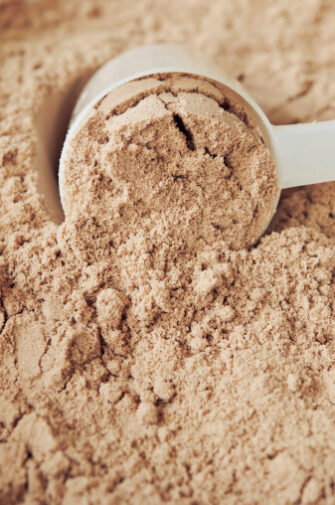Protein powder isn’t just for bodybuilders. These days, you can find a variety of protein powders in mainstream supermarkets, and they can be blended into a wide variety of recipes that are useful in making the health & beauty products.
As a sports and performance nutritionist, I’m often asked about protein powders, including whether they’re healthy, what type is best, and how to use them. My thoughts on this popular product category include pros, potential cons, and top tips.
What is protein powder?

There is no standard formulation, but protein powders are generally made from one or more types of protein, isolated from food, and concentrated into a dried, finely powdered form. Protein powder can be made from animal sources, including eggs and milk whey, casein protein, or various plant sources. Plant proteins can come from foods like peas, soy, brown rice, quinoa, pumpkin seeds, and hemp.
Nutritional breakdown of protein powder
One portion of protein powder is about a quarter of a cup. Usually, a few scoops are included in the package. This one serving can easily contain 20-25 grams of protein. Most powders are low in fat and carbohydrates. To figure out how a powder serving fits your daily protein needs, figure out your overall goal for this crucial macronutrient.
The proposed dietary allowance for a healthy adult with minimal physical activity is presently 0.8 grams of protein per kilogram of body weight daily. For a 150-pound man, that’s about 55 grams of protein daily. However, protein needs may increase depending on your tasking level and age. For example, 1.4 to 2 grams per 2.2 pounds of body weight may be required to build muscle through strength training, and 1 to 1.2 grams per 2.2 pounds of body weight is recommended for those over 65.
If your protein requirement is 60 grams daily, one serving of protein powder can meet a solid one-third of your daily goal. This is quite significant.
Another way to judge the nutritional value of a protein powder is to compare the amount of protein it provides with that of other protein-rich foods. One portion of most protein powders contains about the equal amount of protein as a 3-ounce boneless chicken breast and a few grams more than a cup of cooked lentils.
With that in mind, the two best ways to use protein powder are as an alternative to other protein-containing foods and to increase the protein content of a dish usually low in protein. For example, a smoothie made from vegetables and fruits lacks protein; even a few tablespoons of almond butter only add about 6 grams. Mixing the powder can quickly increase the protein content to a more significant percentage of your daily needs, turning the drink into a meal replacement.
What to look out for when buying protein powder
I generally suggest opting for plain, unflavored, unsweetened protein powders. These products allow you to add sweeteners and flavor the powder with all-natural spices. Plain powders are also more versatile as they can be used in health & beauty products. Plus, they’re usually free of unwanted ingredients like artificial flavors and sweeteners.
Check ingredient lists and look for labels where the only ingredient is the protein, such as “pea protein isolate” or “sprouted brown rice protein.” This means that some ordinary powders add probiotics and enzyme mixtures. Although not necessary, these supplements can be beneficial, especially if you are not consuming them from other sources of health & beauty products.
One possible concern about protein powder
Several tests have analyzed protein powder for contaminants such as heavy metals over the years. One such test was performed by the Clean Label Project in 2018. Of more than 130 protein powders tested, the group found that 75% of the products examined contained measurable lead levels. This and other study results seemed concerning, so a 2020 study published in Toxicology Reports looked at the potential health effects of consuming protein powders.
How to use protein powder
Protein powder is more versatile than you think. It mixes well in smoothies, but you can add it to oatmeal or overnight oats, pancakes, breakfast cookies, energy balls, and bars. Protein powder can also be mixed into soups (I add it to vegan butternut squash soup), hummus, veggie burger patties, and pizza crusts.
So, is protein powder healthy?
The conclusion is not to add protein to everything you eat. Instead, it’s to meet (and not exceed) your daily protein needs. As for whether or not protein powders are a healthy way to do this, a simple-ingredient, plant-based choice certainly can be—especially if it’s been tested for contaminants.
Of course, the starting point should always be wholesome, naturally nutrient-rich foods. In these unprocessed foods, protein is associated with fiber and a wide variety of other nutrients and bioactive compounds. But when combined with other whole foods, protein powder can offer a simple and convenient way to help you meet your daily protein goal. These health & beauty products can also help you cut back on meat and dairy and enjoy more balanced plant-based meals.